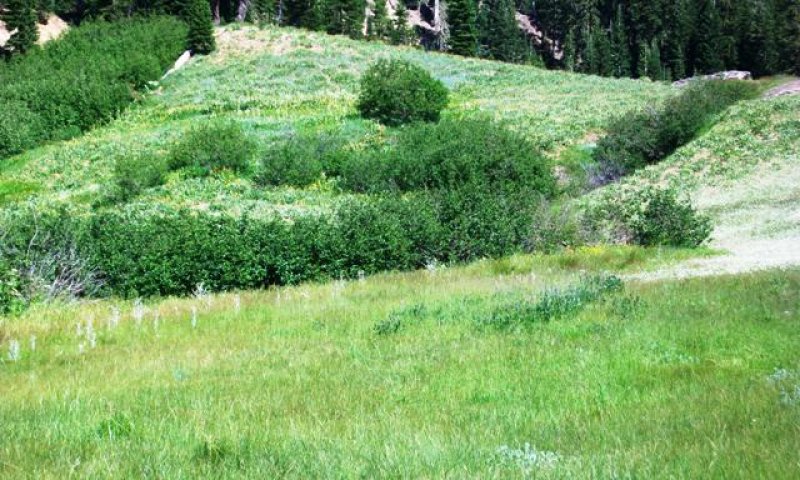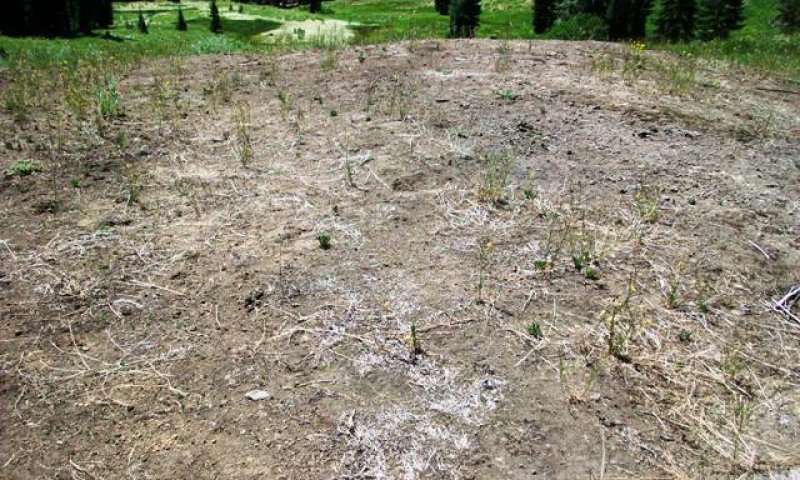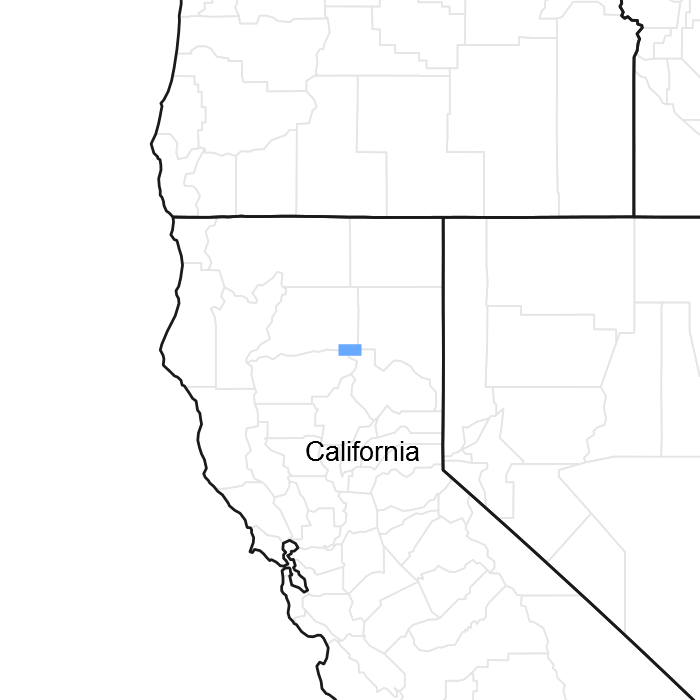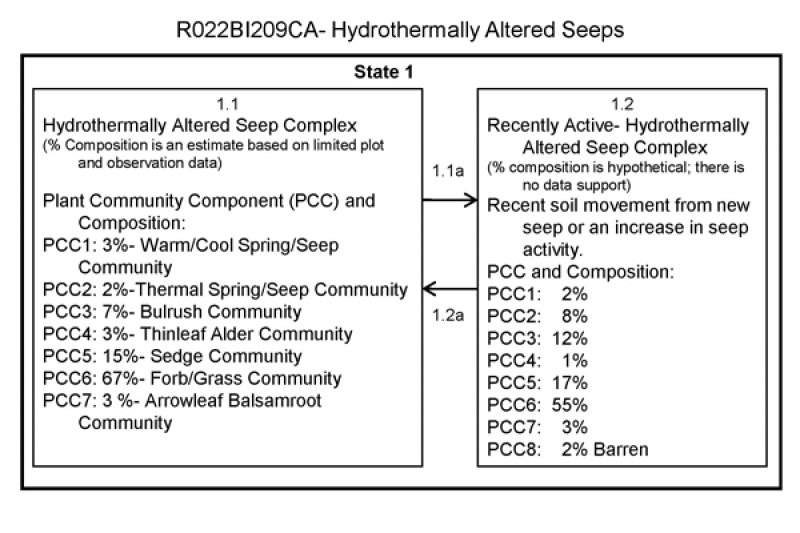State 1
State 1
This state represents the natural conditions for this ecological site.
Community 1.1
Hydrothermally Altered Seep Complex

Figure 3. Loamy Seeps View

Figure 4. PCC1- Warm/Cool Spring/Seep

Figure 5. PCC2- Thermal spring/Seep

Figure 6. PCC3 Bulrush

Figure 7. PCC4- Thinleaf Alder

Figure 8. PCC5- Sedge

Figure 9. PCC6- Forb/ Grass

Figure 10. PCC7- Arrowleaf Balsamroot
There is a wide variety in micro-habitats within this ecological site and the plant communities associated it. The sloping valley generally has an active hot or cool spring at the upper ends of the meadow. These springs provide water for the meadow plant communities down the drainage.
Six dominant plant communities have been identified, but there are several other plant communities present.
PCC1: Warm/Cool Spring/Seep Community
This plant community is found at the source of a spring or seep. The composition of plant species in this community is highly variable. Soil-vegetation data was not collected at the source of these springs, so this plant community is based on field notes and photos. Several variables affect the vegetation at the spring, including water temperature, water chemistry, valley slope, soil stability, and flow rate. The photo above for PCC11 is from a stable, cool temperature seep with low flow. It is surrounded by sedges (Carex spp.), mosses, alpine shooting star (Dodecatheon alpinum), American bistort (Polygonum bistortoides), spikerush (Eleocharis spp.), and Howell's marsh marigold (Caltha leptosepala ssp. howellii). Annual production was not collected for this community type.
PCC2: Thermal Spring/Seep Community
This community is found at the source of active thermal springs. Most of these hot springs have neutral pH and low chloride concentrations. The hot springs are associated with the nearby steam vents, formed from vapor-dominated hydrothermal systems. Precipitation infiltrates over time through the rock, then vaporizes and rises to the surface (Thompson, 1985).
Hot springs have variable characteristics. For example, the one in the photo above and described here emerged onto a flat terrace of calcified material. Shortly after emerging, a mat of algal growth forms in the water and along the margins of the small stream. The spring is bordered primarily by seep monkeyflower (Mimulus guttatus). A complex microbial community lives in the geothermal waters but a detailed investigation and description of these microbial communities is beyond the resources for this ecological site at this time. Hot springs ecology is a relatively new science, but studies conducted in Lassen Volcanic National Park indicate that several microbial communities are associated with specific hot spring characteristics. Microbes reside in thermal waters within specific zones of tolerance for temperature and acidity. A study in Cold Boiling Lake indicates that sulfur-metabolizing archaeans are present in the hottest zones (above 60 degrees C), with iron-oxidizing bacteria in cooler zones and photosynthetic algae and cyanobacteria in more moderate zones. Cold Boiling Lake is acidic however, so it’s possible the microbial communities may differ for this site. Cyanobacteria and algae species form thin, dense green microbial mats. These mats are an ecosystem unto themselves with a diversity of organisms, each performing a specific task within the system. The cyanobacteria are on the surface of the mats and produce oxygen through photosynthesis. The oxygen filters into the lower layer where aerobic bacteria and archaea utilize it. The respiration between these organisms can deplete oxygen, creating an anoxic zone where purple sulfur bacteria reside. The purple sulfur bacteria use sulfide produced from sulfide-reducing bacteria (Wilson, et al., 2008 and Engleman).
PCC3: Bulrush Community
This community is found in wet saturated areas near spring sources. It is composed of panicled bulrush (Scirpus microcarpus), Congdon's bulrush (Scirpus congdonii), field horsetail (Equisetum arvense), Ranunculus flammula (greater creeping spearwort), bugle hedgenettle (Stachys ajugoides), willowherb (Epilobium sp.), and Douglas' sagewort (Artemisia douglasiana). This is not a complete species list. Annual production ranges from 3,000 to 3,500 lbs/ acre.
PCC4: Thinleaf Alder Community
The thinleaf alder (Alnus incana ssp. tenuifolia) community is found along active stream channels. Although thinleaf alder dominates, a variety of other species are present, including fowl mannagrass (Glyceria striata), field horsetail (Equisetum arvense), bugle hedgenettle (Stachys ajugoides), willowherb (Epilobium sp.), Douglas' sagewort (Artemisia douglasiana), California false hellebore (Veratrum californicum), and arrowleaf ragwort (Senecio triangularis). The cover of thinleaf alder is very dense, and the diversity and production of the understory is low beneath the canopy. In the canopy openings associated species exhibit higher cover and production. Production of mountain alder ranges from 2,800 to 3,500 lbs/acre. Production of the associated species in the canopy openings (adjusted for production across the landscape) ranges from 300 to 500 lbs/acre.
PCC5: Sedge Community
The sedge plant community is found in stable, flatter areas. It is generally separated from the spring source by a seep community or the bulrush community. It is dominated by mixed sedges (Carex spp.), including littleleaf sedge (Carex luzulifolia), smallwing sedge (Carex microptera), Nebraska sedge (Carex nebrascensis), and analogue sedge (Carex simulata). Other common species are tundra aster (Oreostemma alpigenum), willowherb (Epilobium sp.), tinker's penny (Hypericum anagalloides), Scouler's St. Johnswort (Hypericum scouleri Hook. ssp. scouleri), and mountain rush (Juncus arcticus ssp. littoralis). Species from the grass and forb community are present in small amounts. Annual production ranges from 2,800 to 3,300 lbs/ acre.
PCC6: Forb and Grass Community
This community is dominated by California false hellebore (Veratrum californicum) and arrowleaf ragwort (Senecio triangularis). Other species that may be present include common yarrow (Achillea millefolium), western needlegrass (Achnatherum occidentale), pussytoes (Antennaria sp.), California brome (Bromus carinatus), squirreltail (Elymus elymoides), blue wildrye (Elymus glaucus), common cowparsnip (Heracleum maximum), meadow barley (Hordeum brachyantherum), bigleaf lupine, (Lupinus polyphyllus), and yampah (Perideridia sp.). Annual production ranges from 3,200 to 3,600 lbs/acre.
PCC7: Arrowleaf Balsamroot Community
The arrowleaf balsamroot (Balsamorhiza sagittata) community is found adjacent to the wet meadow and on dry hummocks within the meadow. It is heavily dominated by arrowleaf balsamroot, with a low cover of longspur lupine (Lupinus arbustus), mountain monardella (Monardella odoratissima), Indian paintbrush (Castilleja sp.), California brome (Bromus carinatus), squirreltail (Elymus elymoides), and yampah (Perideridia sp.). Western white pine (Pinus monticola), California red fir (Abies magnifica), and mountain hemlock have low cover. Annual production ranges from 500 to 900 lbs/acre.
If this site becomes permanently stable there is some indication that thinleaf alder thickets may develop. This would be another state, but without data support this state was not included at this time.
Community 1.2
Recently Active- Hydrothermally altered seep complex

Figure 11. Headcut

Figure 12. Barren
This Community Phase is a natural phase within State 1. It has the same plant community components as Community Phase 1.1, but the relative distribution of each component has shifted due to changes in hydrology. Additional research into the activity rate of the hot springs and soil movement would be beneficial to determine the impact of these activities on this ecological site. Such research may indicate additional community phases. The scale of impact could potentially be larger than indicated here.
Spring flow can easily be diverted by buildup of microbial and vegetative root mats. The barren community in the photo above was created when the small stream was diverted by a dense vegetative growth of seep monkeyflower. The subsequent decline in water availability caused the hydrophytic vegetation to decline and the more upland species have not yet established. With time these hummocks will re-vegetate. The plant community that will return depends upon water table depth.
The hummocky nature of these sloping meadows may be a result of slow soil movement. As the fine textured soils saturate and become viscid, the stream headcuts through the lower toeslopes of the hummocks as it tries to regain a natural gradient. As the stream down cuts, it creates drier terraces above the channel. The forb/grass community may replace the wetter community components.
PCC8, Barren Community
This community is basically barren, but there are scattered plants present including mountain rush (Juncus arcticus ssp. littoralis), seep monkeyflower (Mimulus guttatus), bugle hedgenettle (Stachys ajugoides), Douglas' thistle (Cirsium douglasii), Douglas' sagewort (Artemisia douglasiana), mat muhly (Muhlenbergia richardsonis), and sanddune wallflower (Erysimum capitatum). Annual production has not been collected on this plant community but is estimated to be between 10 to 70 lbs/acre.
Pathway 1.1a
Community 1.1 to 1.2
Hydrothermally Altered Seep Complex
Recently Active- Hydrothermally altered seep complex
This pathway is created by changes in spring flow, channel course, or stream gradient, which alters the surrounding hydrology and plant communities.
Pathway 1.2a
Community 1.2 to 1.1
Recently Active- Hydrothermally altered seep complex
Hydrothermally Altered Seep Complex
This pathway is created during periods of stability.













